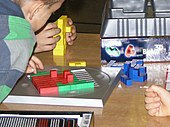Blokus
There are a total of 84 game tiles, organized into 21 shapes in each of the four colors: blue, yellow, red, and green.
Blokus Trigon uses pieces made up of triangles rather than squares (polyiamonds) and is played on a hexagonal board.
Like Blokus Duo, it is played by two players on a 14×14 board, but it uses only a subset of the pieces that have simpler shapes.
The objective is to build one of four different structures, each with its own placement limitations: the Tower, Wall, Steps, and Pyramid.
Players attempt to place their blocks to make sure they have as many squares of their color on top of the structure as possible.
Irem was the first to develop such a kind of video game, in the form of what is known as Blokus Club with Bumpy Trot.
Released in December 2007, Blokus World Tour was similar to the board game version of Blokus but also featured 16 AI opponents, music and sound effects, and multiple game modes, including a tour mode, quick play, and a challenge series.
[8] Gameloft developed and released an official Blokus video game for iPhone, iPod Touch, and iPad in April 2010, featuring the Classic and Duo versions of the game, local and online multiplayer gameplay, and single player tournament mode.
The most recent officially licensed Blokus app was developed by Magmic, and was available for iPhone, iPod Touch, and iPad.
This version included solo play and multiplayer options, integrating the users' Facebook and Game Center friends and allowing them to compete on a tournament leaderboard.
Open-source derivatives based on the same concept of polyominoes as Blokus also exist, such as: Blokish,[13] Blockem,[14] or Pentobi.
Lastly, one free, closed-source implementation is Blokee,[18] playable immediately on the Web with other players and/or AI, and requiring no software download nor account setup to play.




